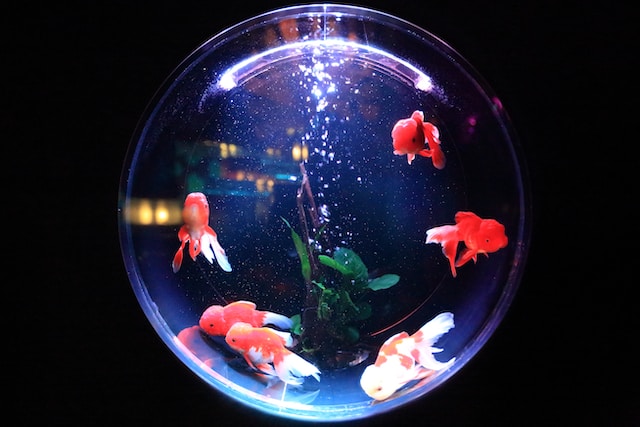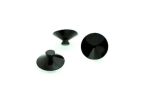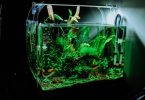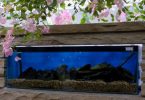Table of Contents
Leaving the aquarium light on 24/7 is a common question among fish owners. While some believe that leaving the light on all day can mimic the natural environment of the fish, others argue that it is harmful to their health.
The answer is not straightforward, as it depends on several factors, including the type of fish, live plants, and the lighting setup.
As a general rule, aquarium lights should be kept on for 6 to 12 hours maximum per day. Leaving the light on for more than 12 hours can lead to several problems, including accelerated algae growth, disturbed sleep cycles for the fish, and health issues.
Fish need to sleep just like humans, and light can disrupt their sleep schedule. However, if you have an aquarium with live plants, the light can provide photosynthesis and help the plants grow, and it may be safe to leave the light on for 24 hours.
The Importance of Light in an Aquarium
When setting up an aquarium, one of the most important factors to consider is lighting. Aquarium lighting serves multiple purposes, including providing light for photosynthesis, promoting plant growth, and influencing the health and behavior of fish.
Photosynthesis and Plant Growth
Aquarium plants require light to carry out photosynthesis, a process that converts light energy into chemical energy.
This energy is then used to fuel the plant’s growth and other metabolic processes. Without adequate light, aquarium plants will struggle to grow and may even die.
Different species of aquarium plants have varying light requirements, so it’s important to research the specific needs of the plants in your aquarium. Some plants require high levels of light, while others can thrive in low light conditions.
Fish Health and Behavior
Lighting also plays an important role in the health and behavior of fish. Tropical fish, for example, require a certain amount of light to maintain their natural circadian rhythms. Nocturnal fish, on the other hand, may become stressed if exposed to too much light during the day.
Fish also require periods of darkness to sleep and rest. Leaving the aquarium light on 24/7 can disrupt their sleep schedule and lead to increased stress levels.
Furthermore, excessive light exposure can lead to the overgrowth of algae, which can harm the fish and other aquatic life in the tank.
It’s important to strike a balance between providing adequate light for the plants and fish, while also preventing the overgrowth of algae.
Ambient Lighting
In addition to aquarium lighting, it’s also important to consider the ambient lighting in the room. Natural sunlight and other sources of light can affect the aquarium’s lighting and temperature. It’s important to place the aquarium in an area that receives consistent, indirect light and avoid placing it in direct sunlight or near windows.
In summary, aquarium lighting serves multiple purposes, including promoting plant growth, influencing fish health and behavior, and preventing the overgrowth of algae.
It’s important to research the specific lighting needs of the plants and fish in your aquarium and strike a balance between providing adequate light and preventing excessive light exposure.
Can You Leave Your Aquarium Light On 24/7?
Aquarium lights are an important aspect of a healthy and thriving aquarium ecosystem. However, many aquarium owners are confused about how long they should leave their aquarium lights on. Some may wonder if it’s safe to leave their aquarium light on 24/7.
The Risks of Leaving Your Aquarium Light On 24/7
Leaving your aquarium light on 24/7 can have several risks. One of the most significant risks is the growth of algae in your aquarium.
Algae thrive in light, and leaving your aquarium light on constantly can lead to an overgrowth of algae, which can be harmful to the health of your fish.
Additionally, leaving your aquarium light on 24/7 can disrupt the day/night cycle of your fish, which can lead to stress and health problems.
The Benefits of Leaving Your Aquarium Light On 24/7
While there are risks associated with leaving your aquarium light on 24/7, there are also some benefits. If you have live plants in your aquarium, leaving your aquarium light on 24/7 can provide the necessary light for photosynthesis and help your plants grow.
Additionally, if you have a well-established aquarium with a healthy ecosystem, leaving your aquarium light on 24/7 can help maintain a stable ambient lighting environment, which can be beneficial for the overall health of your fish.
Other Considerations
It’s important to remember that fish need rest, just like humans. Leaving your aquarium light on 24/7 can disrupt your fish’s sleep schedule and circadian rhythm, which can lead to stress and health problems.
It’s recommended to provide your fish with a consistent day/night cycle by turning your aquarium light on for 6-12 hours per day and turning it off at night.
Additionally, ambient room lighting can also impact your aquarium environment. If your aquarium is in a room with bright ambient lighting, it’s recommended to turn off your aquarium light during the day to avoid overexposure to light.
Overall, while there are some benefits to leaving your aquarium light on 24/7, the risks outweigh the benefits.
It’s important to provide your fish with a consistent day/night cycle and avoid overexposure to light to maintain a healthy and thriving aquarium ecosystem.
Types of Aquarium Lighting
When it comes to aquarium lighting, there are several types to choose from. Each type has its own advantages and disadvantages, so it’s important to choose the right one for your aquarium. Here are the three most common types of aquarium lighting:
Incandescent Lighting
Incandescent lighting is the oldest and most traditional type of aquarium lighting. It is also the least expensive.
However, it is not very efficient and can produce a lot of heat, which can be harmful to fish and plants. Incandescent lighting is best suited for small aquariums with low light requirements.
Fluorescent Lighting
Fluorescent lighting is the most common type of aquarium lighting. It is more energy-efficient than incandescent lighting and produces less heat.
Fluorescent lighting is available in two types: T5 and T8. T5 bulbs are thinner and more efficient than T8 bulbs, but they are also more expensive. Fluorescent lighting is suitable for most types of aquariums.
LED Lighting
LED lighting is the newest and most advanced type of aquarium lighting. It is the most energy-efficient and produces very little heat.
LED lighting is available in a wide range of colors and intensities, making it ideal for all types of aquariums. The Nicrew ClassicLED and Nicrew ClassicLED Plus Planted Aquarium Light are two popular options for LED lighting.
When choosing an aquarium lighting system, it’s important to consider the wattage, lumen output, color spectrum, and color temperature.
Different types of fish and plants have different light requirements, so it’s important to choose a lighting system that meets their needs.
Light intensity is also an important factor to consider. Some fish and plants require high-intensity lighting, while others require low-intensity lighting.
In conclusion, choosing the right type of aquarium lighting is essential for the health and well-being of your fish and plants.
By considering the type of aquarium, the wattage, lumen output, color spectrum, and color temperature, you can choose the best lighting system for your aquarium.
Choosing the Right Lighting for Your Aquarium
When it comes to aquarium lighting, it is important to choose the right type of light, amount of light, and timer to ensure the health and growth of your aquarium plants or corals. Here are some factors to consider when choosing the right lighting for your aquarium.
Type of Aquarium
The type of aquarium you have will determine the type of lighting you need. For example, if you have a freshwater aquarium with stem plants, you will need a different type of lighting than if you have a saltwater aquarium with corals. It is important to research the specific lighting needs for your type of aquarium.
Type of Light
There are different types of aquarium lights available, including fluorescent, LED, and metal halide. Each type of light has its own advantages and disadvantages.
For example, fluorescent lights are energy-efficient and provide a good spectrum of light for aquarium plants, but they may not be strong enough for corals.
LED lights are also energy-efficient and provide a wide range of spectrum options, making them a popular choice for both freshwater and saltwater aquariums.
Metal halide lights provide intense light and are good for high-light aquariums, but they also generate a lot of heat and can be expensive.
Amount of Light
The amount of light your aquarium needs will depend on the type of plants or corals you have. It is important to research the PAR (photosynthetically active radiation) needs of your plants or corals to determine the appropriate amount of light.
Generally, aquarium plants need 8-10 hours of light per day, while corals may need up to 12 hours of light per day.
Timer
Using a timer for your aquarium light is important to ensure consistency in the amount of light your aquarium receives.
It is recommended to use a timer to provide 8-12 hours of light per day, depending on the needs of your aquarium plants or corals.
Overall, choosing the right lighting for your aquarium is crucial for the health and growth of your aquatic plants or corals.
By considering the type of aquarium, type of light, amount of light, and timer, you can provide the best lighting conditions for your aquarium.
Conclusion
In conclusion, leaving an aquarium light on for 24/7 is not recommended. Most aquarium lights are designed to mimic the natural day/night cycle, and leaving them on for extended periods of time can disrupt this cycle. Additionally, extended periods of light can cause algae growth and other problems.
The recommended amount of time for an aquarium light to be on is 10-12 hours per day. However, there are some exceptions to this rule.
For example, if you have live plants in your aquarium, they may require more light than this. In this case, it is important to research the specific needs of your plants and adjust your lighting accordingly.
It is also important to note that fish need a regular day and night cycle to stay healthy, and leaving the light on 24/7 can disrupt this natural rhythm. In addition, too much light can cause algae growth and stress your fish out.
To maintain a healthy environment for your fish and plants, it is recommended to use a timer to automate the on and off of your aquarium lights.
This will ensure that your aquarium is receiving the appropriate amount of light each day, while also allowing your fish to maintain a regular day and night cycle.
Overall, it is important to be mindful of the amount of light your aquarium is receiving and to adjust your lighting accordingly. By doing so, you can help ensure that your fish and plants are healthy and thriving.







